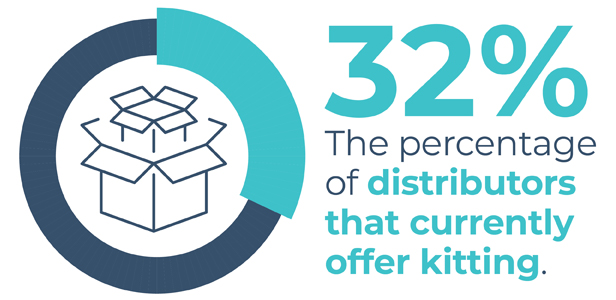May 25, 2021
Deciphering the Complex Puzzle of Fulfillment
Thanks to the pandemic, services like kitting are popular but intricate. Learn the best strategies that will help you deliver.
With the pandemic bearing down on the world in the spring of 2020, it was inevitable that the internationally renowned Boston Marathon wouldn’t be held for the first time in 124 years. Originally slated for April 20, the run was canceled and a virtual one was rescheduled for September.

For official swag provider Juice Marketing (asi/237786) in Kirkland, WA, an already huge project had just gotten much more complex; now, Juice would be sourcing product and kitting pre- and post-race packages for 33,000 recipients in nearly 90 countries.
For the pre-race kits, which included items from major sponsors like Adidas, Clif Bar and Gatorade, Juice received nearly 30 pallets of product over just two days. Normally, all those items would have gone straight to Boston for kitting by event organizers. Instead, Juice’s team had to assemble the packages and get them out the door to destinations all over the world. It wasn’t a foreign concept for the distributor, which had picked and packed for clients’ e-commerce stores before the pandemic from its warehouse spaces in Seattle and Cincinnati. But with the sheer number of packages for the marathon, everything went into overdrive.

(Counselor 2021 State of the Industry Report)
Besides managing shipping to many different countries, Lee Fine, head of sales & strategy, says that Juice also had to coordinate variable data that determined the contents of the post-race kits.
“They couldn’t get mixed up. That was a big part of this,” says Fine. “One person would get a silver medal and a woman’s small shirt, while another would have a bronze medal and a men’s large, for example. The attention to detail had to be spot-on and there was lots of coordinating.”
While not every distributor had an order of this magnitude in the past year, one thing is true: since the pandemic started, many distributors had to get familiar quickly with the complex logistics of fulfillment services like warehousing and kitting.
Before COVID, distributors may have offered warehousing and fulfillment – a service where the distributor would store and ship promo items to end-users as needed, often in bulk to one location. But those services became even more necessary in the midst of remote work. What was once a few boxes shipped to an office for the client to distribute became orders drop-shipped to individual homes by the distributor.

“Before COVID, we did drop-shipping for a couple clients. Now, it’s 90% of them.” Ann Baiden, Innovatex Solutions Inc.
Distributors that offered these services (whether in-house or outsourced to third-party fulfillment providers) were at an advantage, giving end-buyers a way to reach employees, customers and prospects anywhere they resided. As workers retreated to home offices and virtual events exploded, the demand for these services skyrocketed.
“Before COVID, we did drop-shipping for a couple clients,” says Ann Baiden, CEO and founder of Innovatex Solutions Inc. (asi/231194) in Richmond Hill, ON, where a reopening plan is tentatively slated for June after months of stay-at-home orders. “Now, it’s 90% of them.”
This year, another aspect of the process made the puzzle even more complicated: kitting. While it was a nice value-add in years past, distributors now needed the ability to build boxes of products for clients. That involves coordinating arrivals of products from different suppliers, assembling the boxes (many, like the Boston Marathon ones, with variable data) and shipping them to residences.
These services kept more than a few promo firms afloat in the past year. But it’s a complex process. Product arrivals need to coincide so gift packages can be assembled and shipped on time (and ongoing supply chain disruption has made that extremely difficult this year). Drop-shipping requires checking and double-checking long address lists to mitigate the chance of undelivered packages. Shipments come with costs that need to be explained to the client, particularly for international deliveries.
It’s complex, but it’s the direction in which promo is evolving and it’s how companies are diversifying in a rapidly changing consumer landscape. Here are distributor’s hard-won tips for running a streamlined kitting and fulfillment process.
Be Aware of COVID Complications
![]() Running a fulfillment program already has a litany of inherent intricacies, but there’s one challenge looming above them all in 2021: persistent supply chain challenges because of COVID. The costs of raw materials have been rising, containers are stuck at ports around the world and inventory levels at suppliers are quickly depleted and only slowly replenished.
Running a fulfillment program already has a litany of inherent intricacies, but there’s one challenge looming above them all in 2021: persistent supply chain challenges because of COVID. The costs of raw materials have been rising, containers are stuck at ports around the world and inventory levels at suppliers are quickly depleted and only slowly replenished.
And now, because of the huge increase in demand for e-commerce packages, there’s been an attendant rise in costs for corrugated boxes. Fine at Juice Marketing says that custom boxes used to take just a few days; now, it’s more like six weeks. Because of the shortage, when Fine’s team worked on the Boston Marathon project, they had to use two different factories to make sure they had enough materials. “The boxes had to match exactly,” he notes. “That’s a scary thing to use two suppliers when it’s such a high-profile project.”
For Steve Brungart, general manager at Show Your Logo (asi/326179) in Oswego, IL, delays in inventory for one project meant he had to convert his home into a mini distribution center to finish them. A client ordered 2,000 kits that included water bottles; when workers were ready to start kitting, the supplier could only send 1,500. By the time the other 500 arrived, Brungart had to finish kitting in his home garage because other orders were going to his company’s facility. “Before COVID, we had extra space at the office that we thought about selling or leasing out,” says Brungart. “But we needed it again for all the kitting.”
This year, distributors faced slow arrivals of products to be kitted as well as sluggish replenishment of inventory that quickly ran out again. So they’ve created contingency plans. “We’ve had to tell clients to pick four choices of a certain product and then we’d just go down the list,” says Michael Londe, director of sales at Silver Spring, MD-based Summit Group (asi/339116). “Inventory was disappearing faster than we could place orders.”
In addition, personnel changes because of COVID have complicated an already-fragile process. More than a few companies – both within the industry and among end-buyers – are still short-staffed. That causes order hold-ups on the supplier side, as well as distribution challenges for end recipients. Even if an order isn’t being drop-shipped to homes, customers may still want office distribution to be expedited with distributors’ help.
“Clients don’t have the people to sort and organize what comes in,” says Baiden. “Even if the items aren’t going to individual addresses, they still want them organized by size, and labeled with individual names and the person’s shift. That means if a polo is polybagged, we have to open them all and label them.”
Personnel challenges have also been a concern for distributors, especially those with on-site fulfillment operations. To mitigate disruption, Top 40 distributor Integrated Merchandising Solutions (IMS, asi/215310), based in Morton Grove, IL, created “quadrants” of workers who aren’t allowed to come into contact with other quadrants, in order to contain possible spread.
“If someone got sick, the rest of their quadrant was sent home, the area was sanitized and other people picked up the work,” says Mark Lenox, vice present of merchandising and creative for IMS. “We also made sure we had minimal staff in the office. If you were going in, you had to sign in for contact tracing purposes. We wanted to continue operations without a hiccup.”
Special Delivery
![]() An already busy year for e-commerce shipments, and in the midst of ongoing supply chain disruption, 2020 ended with a bang as an explosion of Q4 orders exacerbated already-strained supply lines and freight companies. It became obvious very quickly that promo firms offering fulfillment needed to be discerning about the delivery companies they worked with.
An already busy year for e-commerce shipments, and in the midst of ongoing supply chain disruption, 2020 ended with a bang as an explosion of Q4 orders exacerbated already-strained supply lines and freight companies. It became obvious very quickly that promo firms offering fulfillment needed to be discerning about the delivery companies they worked with.
Elizabeth Tate, CEO of Signet Inc. (asi/326636), a certified women-owned distributorship in Memphis, TN, says her team uses UPS along with FedEx PowerShip for large volumes and overseas shipping. (ASI members receive flat rate discounts on shipping with UPS as well as savings on fulfillment services from Xpedite Fulfillment.) Both platforms allow for quick barcoding and calculation of fees, so the company can communicate it to clients at the front-end. Addresses are usually easy to import, as long as they’re correct from the client.
“We have to check addresses all the time,” says Tate. “But as long as they send them to us in spreadsheets, we can download them and that saves time.”
Inevitably, with so many packages headed out the door, there are bound to be undelivered or lost shipments. Impress on clients the urgency of making certain that each address is correct and the most up to date. Use address checking functions within the shipping software if they’re available, and have a few people take a look at the list manually to make sure all necessary elements are present.

“Clients don’t always do the math. They’ll say they need 1,000 pieces, and once we add up the product and freight costs it comes out to twice their budget. It surprises them.” Michael Londe, Summit Group
“We always have people check the information with a fresh set of eyes,” says Steve Gentile, managing partner at Pinpoint Promotions (asi/163341) in West Haven, CT. “We’re proactive and we’ll send a template to the client. Mistakes happen, but we’re giving and collaborative. We just make it right, instead of trying to figure out who’s to blame.”
Certainty is crucial, says Mitch Silver, vice president of marketing and sales at Printable Promotions (asi/299458) in Chicago, which uses services that calculate costs at the front-end. “Clients hate when we say, ‘It depends’ or ‘We can’t tell you,’” says Silver.
To ease the shipment process, work with providers that offer accurate cost estimates that can be communicated to end-buyers early on in the process. “Our shippers look at tariff codes at the beginning and what will be incurred,” says Lenox. “We don’t want surprises and neither do clients. We want estimates and quotes up front.”
Ask the client to order extra stock in case packages aren’t delivered or get lost. Londe says they’ll usually have the client’s head office order 10 to 15 extra packages and take care of sending them out if the initial delivery doesn’t arrive. “Sometimes it costs more to have the delivery company reship the package than it does to just abandon it and have the head office ship it again,” says Londe.
Extras are especially important when it comes to apparel. Inevitably, even if the distributor sends out sizing charts, people receive garments that don’t fit. “There’s a lot of back-and-forth with sizes,” says Silver. “So we encourage clients to order extras so they can send out replacements.”
Going International
![]() In addition to work-from-home gifts to keep people connected during the pandemic, brands have also been sending swag to attendees of virtual events. The beauty of virtual is that guests can attend from all over the world. But that can make delivery challenging.
In addition to work-from-home gifts to keep people connected during the pandemic, brands have also been sending swag to attendees of virtual events. The beauty of virtual is that guests can attend from all over the world. But that can make delivery challenging.
With international recipients, distributors stress the importance of managing client expectations. When shipping overseas, for example, the taxes and fees are often calculated and charged after the package has been delivered. Some destinations simply may not be worth shipping to since costs can be extremely high. The cost just for shipping a package could be $65 or more, says Baiden, especially if it’s got a time-sensitive delivery date.
“It’s a long and involved process, depending on where it’s going and the products in the kit,” says Tate. “One client wanted us to send products all over Europe and Asia, with exact cost estimates. There’s no way. Sometimes, I have country names but no exact addresses and they ask for an estimate. We just charge expedite fees if the package has to go far away.”
Brungart said Show Your Logo was recently tasked with shipping out 110 kits. When his team finally received the addresses, 44 of them were international. They told the customer it wasn’t feasible.
“If it’s just one or two, we’ll eat that cost. But not 44,” says Brungart. “Another company in British Columbia with 25,000 recipients wanted us to set up a company store, and we said we couldn’t. The fees for getting things across the border would have been too much. Again, if it was a couple pieces, we would’ve eaten that cost. But we’ve said no when the fees will be a hindrance and the client won’t want to pay.”
If the client is amenable to it, suggest that the overseas recipients are given a gift card they can easily use from home. A $100 gift card could be cheaper than trying to ship them a $5 hat, depending on where they’re located, says Baiden. “You’re better off saving the package for them when they visit the office,” she adds. “Especially if it’s a single package, with the duties, taxes and freight, you’ll end up paying more than it’s worth. We have to rein in the clients. Because of Amazon, they expect it on the doorstep the next day without having to pay for shipping.”
To manage costs when there are significant numbers of virtual event attendees, Silver recommends limiting the number to be shipped out and creating FOMO (fear of missing out). Have event organizers let attendees know that the first 100 to register will receive a box, for example. That way, the client has committed to a certain number, so it makes it easier to budget. It also allows for more sponsorship opportunities, since the client can easily communicate to sponsors what their commitment would be if they’re interested in including an item in the package.
Q&A With Laura Harper
Xpedite Fulfillment
 Laura Harper, president & CEO of Xpedite Fulfillment, a production and distribution company based in Boston and an ASI business affiliate, shares how her company can help distributors offer fulfillment solutions to end-buyers.
Laura Harper, president & CEO of Xpedite Fulfillment, a production and distribution company based in Boston and an ASI business affiliate, shares how her company can help distributors offer fulfillment solutions to end-buyers.
A: We have a network of about 25 facilities, so we can be wherever the client needs us to be: East, West, Midwest, South. Every project is different, so we can adapt to that. We ship within the U.S., as well as into Canada and internationally.
Q: What’s the advantage of working with your company?A: Clients need very specific things. Maybe only two of our 25 facilities would work best for a customer’s order. We decipher where those would be for them specifically, because we’re looking at outbound shipping. Maybe it’s not where our client or their client is based; maybe it’s in the Midwest, for example. Or maybe they’re focused on recipients in New York, so we’ll use a facility there.
We have resources available that helps our clients’ operations. They don’t have to look up a local fulfillment center and try to figure it out themselves. We’ll look at the entire project and see what would work best. We pre-qualify these distribution centers so we know what they can handle. If an order is 500 pieces, or 5,000, or 500,000, we can split it into multiple locations. Our clients don’t have to worry about it. It’s not their expertise. We’re partners with them, so we can figure it out while they focus on their operations and sales.
Q: Where do you see the fulfillment trend going for virtual event items?A: People are anxious to get back to real life, but there are cost savings associated with virtual. It’s flights and hotels versus picking up a Zoom call. Larger events will come back because people want to be with their colleagues, but it’s hard to forecast. In the meantime, companies do want to reach out to individuals directly with marketing pieces, like “lumpy” mail. Virtual events will continue, but not as much. It’ll be hybrid, and they’ll want to start distributing premiums and marketing pieces at shows and events again.
Two-Way Communication
![]() No one can anticipate every challenge that may arise, so prepare for the unexpected. Londe suggests padding shipping times and continuing to confirm freight charges as the order progresses. And make sure to add everything up for the customer at the front-end.
No one can anticipate every challenge that may arise, so prepare for the unexpected. Londe suggests padding shipping times and continuing to confirm freight charges as the order progresses. And make sure to add everything up for the customer at the front-end.
“Clients don’t always do the math,” says Londe. “They’ll say they need 1,000 pieces, and once we add up the product and freight costs it comes out to twice their budget. It surprises them sometimes. Make sure to show them the whole amount and be flexible, because their budget can change very quickly. Know what you can and can’t cancel. But without flights, hotels and food, overall they’re still spending less than they would have if it was in-person.”
Yet another challenge: communicating exact box sizes. Tate will ask a supplier for specific dimensions, and occasionally when the boxes arrive, they’re not the same as what she had ordered. “We think they’ll fit everything and then we find the dimensions are different and we have to get other boxes,” she says. “We also need inventory ship dates from the suppliers so we can keep our staff informed and they’re ready to start kitting when everything arrives.”
While pre-packaged kits from suppliers are helpful to address this type of setback, it becomes challenging when the client wants to add an item to the box, which could change the box size and thus, the budget. “Inevitably, they want to add a food gift,” says Baiden. “So we have to reopen each finished package from suppliers. And samples aren’t as plentiful as they used to be, so we need more information about the extra item at the front-end because it could change the weight, and thus the freight cost.”
Even something seemingly as simple as an enclosed letter adds to the final order price. A generic note on 8.5 x 11 paper is one thing; if it’s personalized and in full color, that cost can be significant. And the client will definitely be charged for labor, since all those letters – personalized or not – have to be handled by employees and placed in each box. Customers need to know that at the beginning before choosing to include them.
With so many moving parts to each order, it’s imperative that distributors maintain consistent communication with clients about ongoing supply chain challenges, current (and potentially rising) costs for product and shipping, overages, and delivery obstacles because of overextended freight companies. But when managed well, a streamlined kitting and fulfillment process can allow a promo firm to stand out from the stiff competition. It’s a new normal that companies would do well to embrace.
“We’re no longer sending 100 hats to one corporate location,” says Baiden. “Those days are long gone. We’ll see a lot of aspects of this process become permanent.”
Remember This
Here are top fulfillment tips from distributors who’ve learned a thing or two during this hectic year.
 “Communicate with the client. They need a full expectation of what they’ll be charged. It’s tempting to go in with a low quote and make it up with other charges. But that’s a bad way to do business. If you don’t know how much it will cost, figure out a way to estimate it.” Mark Lenox, IMS
“Communicate with the client. They need a full expectation of what they’ll be charged. It’s tempting to go in with a low quote and make it up with other charges. But that’s a bad way to do business. If you don’t know how much it will cost, figure out a way to estimate it.” Mark Lenox, IMS
 “Get good at using the address checker in your shipping software. Check large lists before downloading them into the software, to avoid mistakes. No two projects are alike, so it helps to get the process down pat.” Elizabeth Tate, Signet Inc.
“Get good at using the address checker in your shipping software. Check large lists before downloading them into the software, to avoid mistakes. No two projects are alike, so it helps to get the process down pat.” Elizabeth Tate, Signet Inc.
 “Put together a pricing sheet: ‘If you have X number of pieces and X number of boxes, here’s the estimated price.’ Our processes and systems are getting better and better. There are a lot of moving parts, but like I tell my kids: ‘Every expert was once a beginner.’” Mitch Silver, Printable Promotions
“Put together a pricing sheet: ‘If you have X number of pieces and X number of boxes, here’s the estimated price.’ Our processes and systems are getting better and better. There are a lot of moving parts, but like I tell my kids: ‘Every expert was once a beginner.’” Mitch Silver, Printable Promotions
 “Be flexible. Sometimes, you need to control the client’s expectations and know when to say no, but flexibility helps us get the business. The sales reps are strict but they’re also making the sale. We try to work with flexible suppliers that will kit other products besides their own. And communication is key, for both suppliers and distributors.” Steve Brungart, Show Your Logo
“Be flexible. Sometimes, you need to control the client’s expectations and know when to say no, but flexibility helps us get the business. The sales reps are strict but they’re also making the sale. We try to work with flexible suppliers that will kit other products besides their own. And communication is key, for both suppliers and distributors.” Steve Brungart, Show Your Logo
 “Communication goes beyond the products. Add value, like creative ideas and messaging. Have a conversation and create a partnership. Provide innovation, not just products.” Steve Gentile, Pinpoint Promotions
“Communication goes beyond the products. Add value, like creative ideas and messaging. Have a conversation and create a partnership. Provide innovation, not just products.” Steve Gentile, Pinpoint Promotions
 “Fulfillment is here to stay. People will continue to want drop-shipped orders in nice packaging. They’re not putting in new gyms at the office; they want to make an impact when they can’t in person. Events will be dialed back, like how many and how often. Virtual shows won’t totally replace in-person shows, but virtual is less of a trend now and more of a new normal.” Lee Fine, Juice Marketing
“Fulfillment is here to stay. People will continue to want drop-shipped orders in nice packaging. They’re not putting in new gyms at the office; they want to make an impact when they can’t in person. Events will be dialed back, like how many and how often. Virtual shows won’t totally replace in-person shows, but virtual is less of a trend now and more of a new normal.” Lee Fine, Juice Marketing
